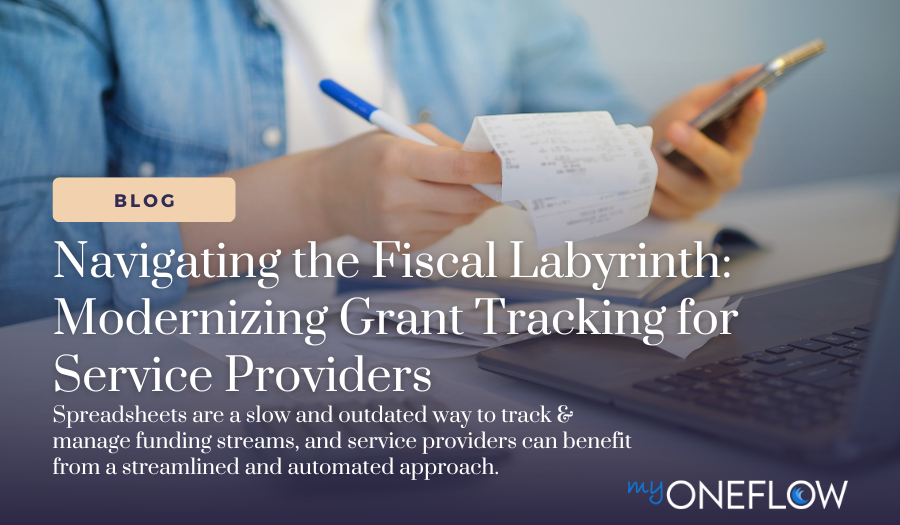1 min read
The Status of WIOA Reauthorization in 2025
This post was last updated on August 25, 2025. To stay informed on future updates, please subscribe to the newsletter. Key Takeaways FY26 Budget...
4 min read
myOneFlow Staff Aug 30, 2024 9:59:45 AM
.png)
The future of workforce development is data, but successfully collecting and utilizing high-quality data remains a challenge for many WIOA-funded organizations on both the local and state levels. Congress's proposed WIOA reauthorization (A Stronger Workforce for America Act, or ASWA) reflects this prioritization with a new funding mandate: states will be required to reserve 5% of Adult and Dislocated Worker funds to award grants to create longitudinal data systems. This measure aims to revolutionize how state agencies and local service providers utilize data to drive informed decision-making and optimize workforce development programs. This blog delves into the transformative potential of this funding requirement, exploring its implications across various levels of the workforce system, and highlights the vital role of data-driven strategies in paving the way for a more efficient and responsive workforce landscape.
The Workforce Data Quality Initiative (WDQI) is crucial in advancing the quality and integration of workforce data systems across the United States. Designed to enhance the development of longitudinal administrative databases, the WDQI seeks to merge workforce data with education data, providing a comprehensive view of an individual's journey from education into the workforce. This initiative targets the refinement and accessibility of performance data, essential for evaluating the effectiveness of employment services and training programs.
A collaborative effort between the U.S. Departments of Labor and Education, the WDQI is part of a broader strategy to build robust, interconnected data systems. These systems are pivotal in ensuring workforce and educational agencies can function synergistically, leveraging data to inform policy decisions and improve program outcomes. By aligning with the Statewide Longitudinal Data Systems (SLDS) initiative, the WDQI supports the creation of data structures that track individuals from early education through their careers, thus offering a dynamic tool for assessing program efficacy and labor market trends.
Longitudinal data systems are invaluable for providing insights into educational and workforce outcomes. They enable policymakers and educators to make informed decisions based on empirical evidence, fostering an environment where data-driven strategies lead to better resource allocation and program optimization. With these systems in place, states and local entities can track progress and anticipate future workforce needs, ensuring that educational and employment pathways are aligned with market demands. Ultimately, the WDQI represents a forward-thinking approach to workforce development, underlining the importance of data as a cornerstone of strategic planning and execution.
If the current proposed version of WIOA reauthorization passes, states will be required to earmark 5% of adult and dislocated worker funding for WDQI grants. This allocation seeks to strengthen the infrastructure of longitudinal data systems, ensuring they are more robust, integrated, and accessible.
Channeling these funds into the WDQI will support states in developing or enhancing their workforce data systems. This includes integrating data from various sources such as employment services, training records, and educational history and outcomes. By doing so, these systems can provide a more comprehensive view of workforce trends and education-to-employment pathways.
Enhancements to these longitudinal data systems promise substantial benefits for workforce development programs. With improved data quality and integration, stakeholders at all levels—from state agencies to local workforce boards—can make more informed decisions. The increased accessibility of high-quality data will allow for better analysis of program performance, enabling targeted improvements and strategic planning. Ultimately, this funding requirement aims to empower entities involved in workforce development to better align their programs with real-world labor market demands, ensuring that both educational institutions and training providers are effectively preparing individuals for the evolving job landscape.
State agencies stand to gain significantly from the enhanced funding allocated through the Workforce Data Quality Initiative (WDQI). By strategically leveraging this financial support, state-level entities can improve the quality and transparency of their workforce data systems. This funding can help workforce boards leverage improved WIOA management technology to integrate disparate data sources, creating a seamless flow of information that allows for more comprehensive data analysis and reporting capabilities.
The potential benefits of improved data integration and analysis are manifold. State agencies can identify and address gaps in workforce development programs, tailor training and educational offerings to meet the actual demands of the labor market, and allocate resources more efficiently. Furthermore, these improvements support evidence-based policy formulation, allowing for the design of strategies that effectively respond to both current workforce challenges and future needs. Ultimately, the enhanced capabilities provided by the WDQI funding can lead to more responsive and effective workforce development strategies, benefiting both individuals and the broader economy.
An increase in WDQI grants can greatly benefit boots-on-the-ground service providers, including career centers, workforce boards, and community colleges. Integrating connected data systems plays a pivotal role in reducing manual data entry, eliminating duplicated efforts, significantly streamlining service delivery, and alleviating the workload on already overburdened staff.
With access to high-quality, integrated data, these service providers can develop more refined and effective programs tailored to the labor market's ever-changing demands. By minimizing manual operations, staff can focus more on strategic planning and participant engagement rather than administrative tasks, thus improving the overall efficiency of workforce development initiatives.
Furthermore, improved data collection and management can help reduce barriers to access for participants by simplifying processes and enhancing the delivery of services. This ensures that more individuals can benefit from educational and training programs to prepare them for emerging job opportunities. With better data integration, workforce boards and community colleges can better collaborate to make informed decisions, adapt quickly to economic shifts, and allocate resources more effectively.
While the proposed mandate for enhanced data collection and management has yet to become law, the imperative for states to prioritize these practices cannot be overstated. High-quality data systems are crucial for effective decision-making and streamlined operations, providing a foundation for state-level agencies and workforce development entities to thrive.
By investing in modern data infrastructure, states can ensure that their workforce development agencies are well-equipped to deliver efficient and impactful services for the future. This strategic focus enhances program efficacy and strengthens economic resilience by aligning training and educational initiatives with real-time labor market demands. By committing to this forward-thinking approach, states can pave the way for a more dynamic, adaptable, and successful workforce development system, ultimately benefiting individuals, communities, and the broader economy.
myOneFlow is the only case management & data solution specifically designed to meet the needs of WIOA-funded organizations. Our mission is to help workforce and adult ed organizations on the state and local levels stay connected and harness the power of their data to simplify compliance and improve outcomes. Compare our package options today to learn more about our offerings.

1 min read
This post was last updated on August 25, 2025. To stay informed on future updates, please subscribe to the newsletter. Key Takeaways FY26 Budget...
.png)
Government social services are crucial in supporting individuals and families in need, providing resources and assistance to significantly improve...

Workforce development and adult education service providers frequently grapple with the intricate task of fiscal and grant tracking. Juggling funds...